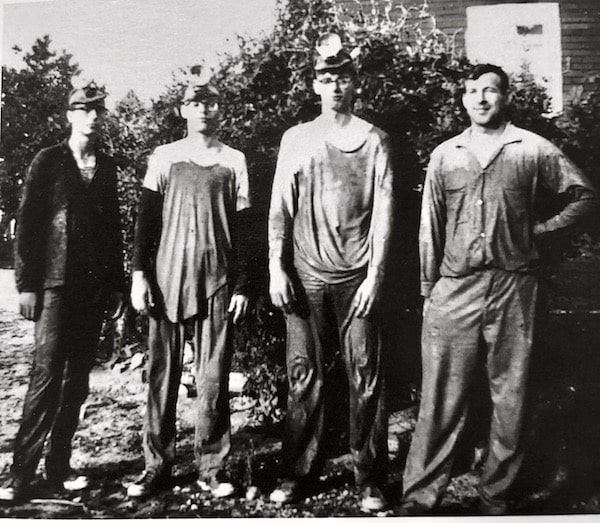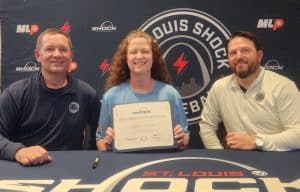Wightman recounts cave discovery

In 1949, a classmate of Paul Wightman named Cletus Meyer told Wightman about a large sinkhole with a cave at the bottom on the property of his uncle, Joel Fogelpole.
“So I said, ‘how soon can we go,’” Wightman remembered.
Wightman, a 90-year-old Waterloo native whose brother owns Wightman Pharmacy, had been interested in caves ever since he saw a picture of a man exploring one in his grandfather’s travel manual.
He did his first spelunking at Illinois Caverns in Burksville, but that paled in comparison to what he would soon discover.
About 20 feet in the sinkhole, Wightman and Meyer discovered a drop-off. The friends figured out how deep the hole was, got supplies and made a rope ladder.
After climbing down, they found a passage that became progressively wider and ended in a large area with passages going several directions.
They had discovered the Fogelpole cave system.
“I can still remember that day,” Wightman said in a nostalgic tone.
Wightman spoke about all this in a jovial speech in front of the crowd who gathered for the opening of the nature preserve that bears his name.
The Paul Wightman Subterranean Nature Preserve opened to the public on May 18 after Clifftop, a local conservation group, spent more than five years getting it ready.
The 535-acre property, located at 3325 G Road in Fults, was bought to protect the cave Wightman and Meyer discovered 70 years ago.
“We’re trying to prevent this cave system from being polluted by too much development overtop of it,” Wightman explained. “This is going to protect a large part of the watershed over Fogelpole’s cave.”
After that first foray into the cave, things changed for Wightman and Meyer.
“Then, we had problems: parents,” Wightman, who now works as a priest in southern Missouri, recalled. “Cletus never came back. I think he was forbidden.”
Wightman continued his exploration, once telling his parents that he and a classmate he was taking with him were going camping so they would not worry.
“When I think back to it, here’s two teenagers going into an unknown cave and there’s no rescue people around,” Wightman said with a chuckle. “And it’s only now that I realize that, but it was fun. It was a first-class adventure.”
The water that runs through the cave served as a guide, ensuring that Wightman never got lost.
The cold liquid, which he estimates was around 50 degrees, could also make exploring the cave uncomfortable.
“At times it was so cold coming out of the cave, and I was changing clothes in the barn and the overalls were so solid you could lean them up against the walls,” Wightman said.
Wightman credits his safety while exploring to his grandmother.
“When I would go caving, my grandmother would say the rosary the whole time,” he recounted. “That’s why I’m here, I think.”
Wightman said his family also became close with the Fogelpoles, so that helped ease his parents’ concern.
“There was a lifelong bond from there, and I think they kind of trusted the Fogelpoles to keep an eye on us,” Wightman noted.
Wightman later left the area for about six years to continue his education.
He returned, however, to help several students map eight miles of the cave.
Wightman would also lead tours of students from local universities who wanted to study the Fogelpole cave system.
Through that work, he learned more about the cave he is credited with discovering.
“The cave is known, they tell me, for biological diversity,” Wightman explained. “There’s a lot of critters in there, but most of them you can’t see. The ones you can see are bats.”
Additionally, Wightman said the cave is home to some raccoons, small salamanders and microscopic creatures, including some previously undiscovered species.
Although he may not have initially had conservation in mind, Wightman said he was careful not to damage any part of the cave.
“When I got interested in caves, it was all adventure,” he said. “It was all fun. Little did I think it would turn out to be a major contribution to ecology. So I’m glad to be part of that. What Clifftop does here enhances that whole project.”
Wightman closed his remarks with a prayer, speaking about the importance of conservation.
“O Lord God, Creator of Heaven and Earth, we thank you for this wonderful time, for the wonders of the beautiful places of southern Illinois – the rocky bluffs, forests, flowering meadows, caves, of course, sinkholes, for the flowers (and) the living creatures who make this their home,” he prayed. “These we hope to pass on to future generations in a pristine way. We thank you for all the dedicated help of many people, the people of Clifftop, who have dedicated their time and resources to help protect this wondrous beauty.”






